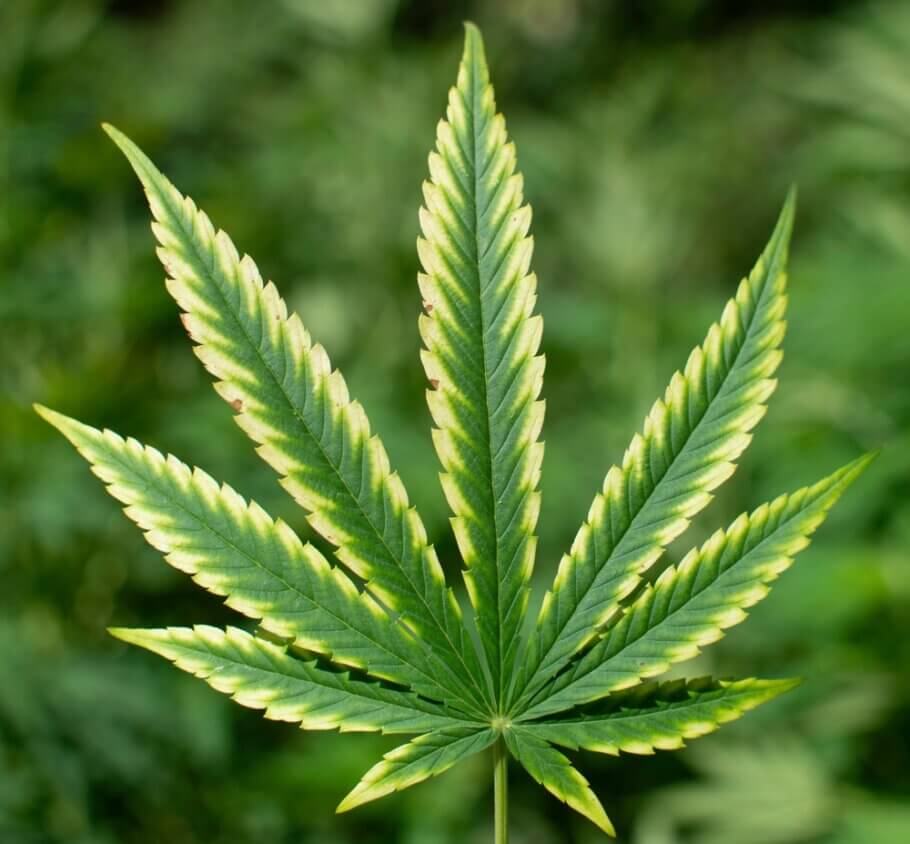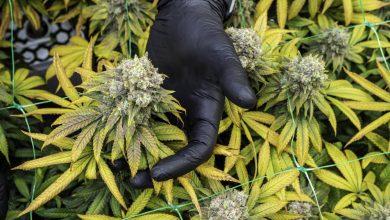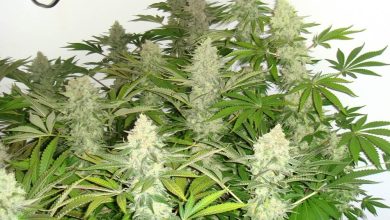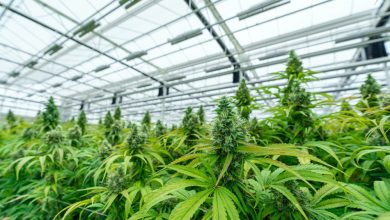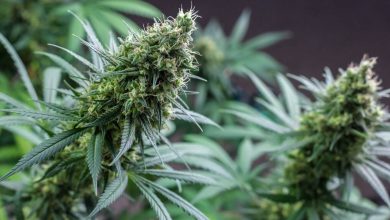Cannabis leaves and their colors- Alchimia Grow Shop
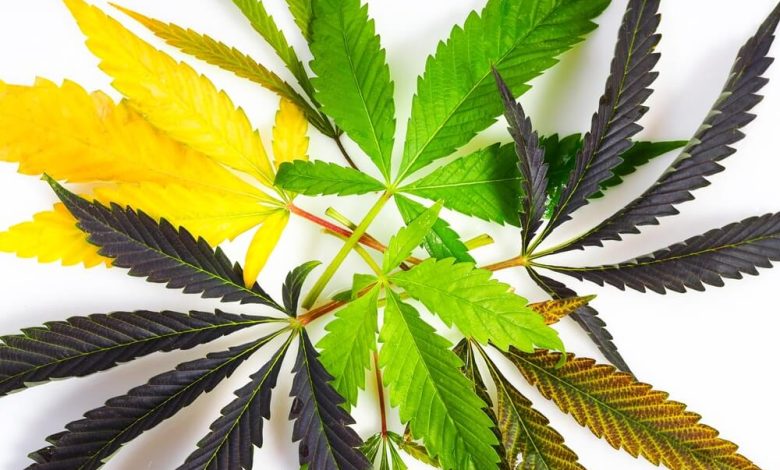
Leaf color in cannabis plants has long been a subject of interest for both growers and botanical enthusiasts. While deep green is the predominant color, especially during the vegetative growth stage, the color palette in cannabis can include shades of red, yellow, lilac, purple, and even almost black, often seen during flowering.
These color changes not only offer a beautiful visual spectacle but can also provide key information about the plant’s health, genetics, and growing conditions. Throughout this article, we will explore the causes behind these color variations and how to interpret the colors on cannabis leaves to improve the quality of the crop, if necessary. Let’s go!
Cannabis leaves
In addition to having become a true symbol of the plant and its use, cannabis leaves are complex and functional structures that are essential for the correct growth and flowering of plants. Their characteristic shape, with various thin leaflets and serrated edges, maximizes light capture, which helps the plant in its photosynthesis process. This function is essential for growth since, as you know, photosynthesis converts light into energy, which is essential for the plant’s development.
But beyond their functionality, leaves also act as indicators of the plant’s health and environment, offering growers early signs of potential problems such as nutrient deficiencies, diseases, pests, or environmental stress. As we will see later, carefully observing the color and texture of leaves is crucial to understanding the overall condition of the plant and adapting care according to its needs.
Why are leaves green?
The green color of cannabis leaves comes from chlorophyll, a plant pigment that plays a fundamental role in the process of photosynthesis and can be found in plants, most algae, and cyanobacteria. Chlorophyll absorbs light of red and blue wavelengths, reflecting green light, which gives the leaves their characteristic color. This pigment is essential for the plant to convert light into energy, so the level of chlorophyll directly reflects the health of the plant.

When the plant faces nutritional problems such as nutrient deficiencies (particularly nitrogen) or an unbalanced pH in the soil, chlorophyll production can decrease, causing leaf color changes to paler or yellower tones. As the plant ages, or during the flowering stage, chlorophyll can also naturally decrease, giving way to other pigments that give the leaves a beautiful color palette and allow the grower to enjoy a true visual spectacle.
Genetics, environmental conditions, and nutrition
The color of cannabis leaves is not only determined by the pigments present, but can also be influenced by genetics, environmental conditions, and nutrition. Due to genetics, some strains are predisposed to develop certain colors; for example, indica varieties tend to be darker in color, while some sativas tend to be lighter in green, a difference in tone often seen in growth and flowering. In addition, exposure to cooler temperatures, especially at night (conditions encountered by many indicas), can intensify the production of anthocyanins in predisposed plants, causing more intense colors such as purple and lilac.
Nutrition also plays a key role in leaf color. Deficiencies in essential nutrients, such as nitrogen, phosphorus, or potassium, cause discolorations and spots that can alert the grower to potential problems in the soil or nutrient solution. A proper nutritional balance helps maintain a healthy, deep green color, while changes in this balance can result in unusual colors. These usually show yellow discolorations in one pattern or another, depending on the nutrient (or nutrients) causing the problem.
Micronutrients and Marijuana plants
In this post we explain you the different micro-elements that the plant needs, as well as their role, so you can identify and correct the possible deficiencies and excesses that marijuana plants can have during their growing and flowering.
Leaves of other colors: the pigments of cannabis
In cannabis plants, the main pigments are:
- Chlorophyll: This pigment gives most cannabis leaves their characteristic green color. It is essential in photosynthesis, capturing light and transforming it into energy.
- Carotenoids: These are responsible for yellow, orange, and red hues. These pigments also aid in photosynthesis and protect the plant from damage caused by excessive light.
- Anthocyanins: These are pigments that produce purple, lilac, red, and blue hues. Their production can be stimulated by factors such as cold temperatures or stress conditions and varies according to the genetics of the plant.
- Flavonoids: These include compounds such as quercetins and kaempferols, which can impart a yellow color or contribute to the overall tone of the plant. They also protect against UV rays and various pathogens.

These pigments not only give cannabis its color but also perform critical functions for its health and adaptation to the environment. Depending on the proportion of these pigments in the leaves, they will have different colors:
- Yellow: Yellowing of cannabis leaves usually indicates a nutrient deficiency, especially a nitrogen deficiency, or an improper pH in the growing medium that is preventing nutrient uptake. It can also be a sign of stress, whether from extreme heat conditions, overwatering, or lack of light. During flowering, it is common for the lower leaves to turn yellow as the plant directs its energy towards the flowers.
- Lilac/Purple: Lilac or purple-hued leaves are also related to anthocyanins, pigments that develop under cold temperatures or when plants experience controlled stress. This color is particularly common in certain varieties, such as Purple Punch x Do-Si-Dos or Red Red Wine, and appears in response to temperature variations and specific genetic conditions. The variation in the intensity of lilac and purple can depend on the genetics of the plant and the environment in which it is grown.
- Red: Red or orange leaves on cannabis plants can appear due to the presence of anthocyanins and carotenoids, pigments that can develop in response to low temperatures or environmental stressors. It can also be seen in plants with a phosphorus deficiency. Strains with genetics that facilitate the development of anthocyanins and carotenoids (such as the Dark Devil strain) are prone to developing reddish tones in cold environments.

- Black: Almost black leaves are less common and usually arise from an extreme accumulation of purple pigments or as a result of a reaction to very cold temperatures. This color can be found in varieties specifically hybridized to highlight dark tones, such as Frozen Black Cherry, offering a particular visual appeal. Dark colors usually appear in the final phase of flowering, when environmental conditions stimulate the development of pigments.
As you can see, cannabis leaf color is a useful tool for growers, who can interpret color variations as signals about the health, genetics, or environment of their plants. Understanding the cause behind color tones allows for adjustments to be made in crop care, optimizing factors such as nutrients, temperature, and light exposure. In short, cannabis leaf colors not only beautify your crop but also make it easier for you to manage the environment and ensure a high-quality, high-yield harvest.
Happy harvest!
